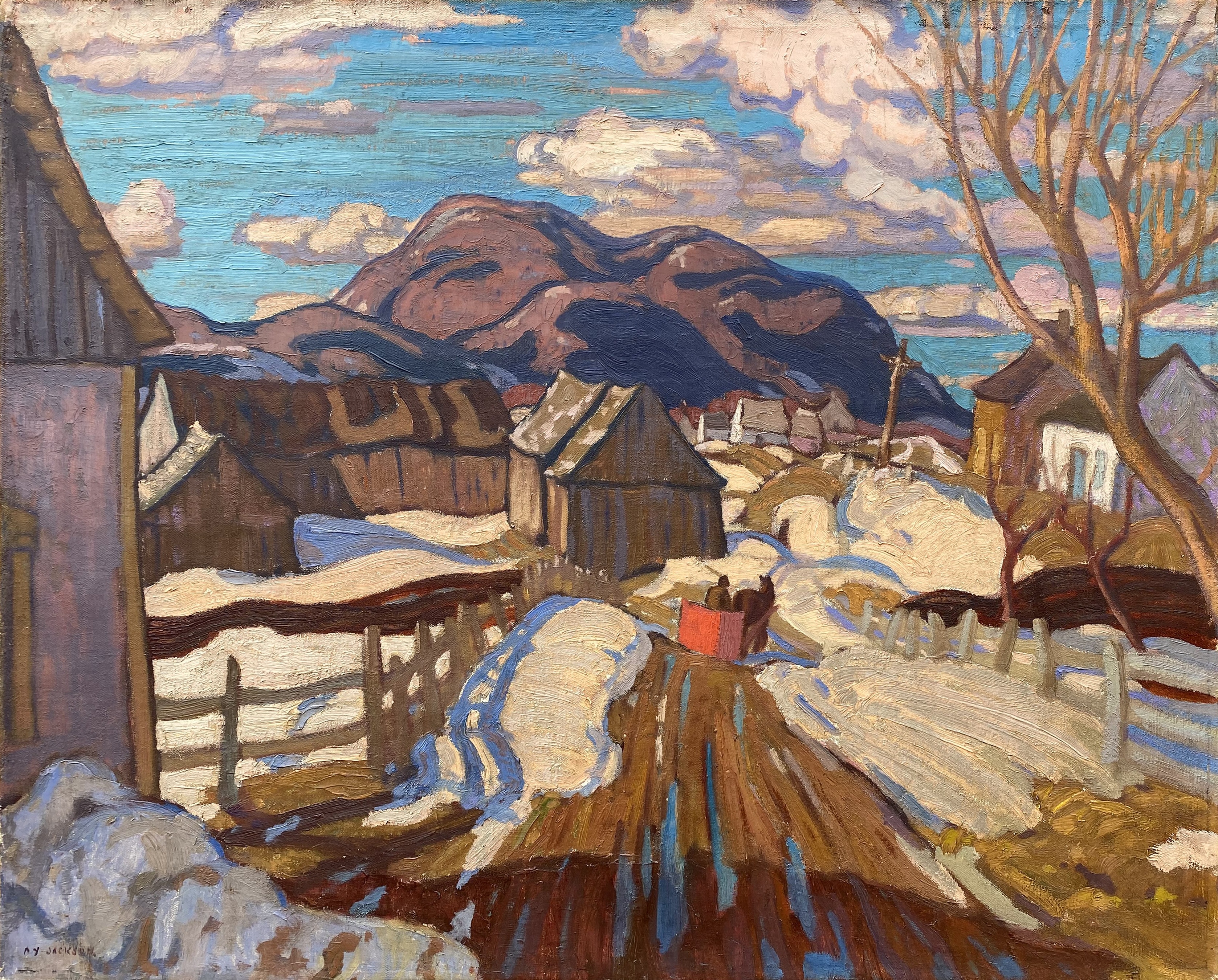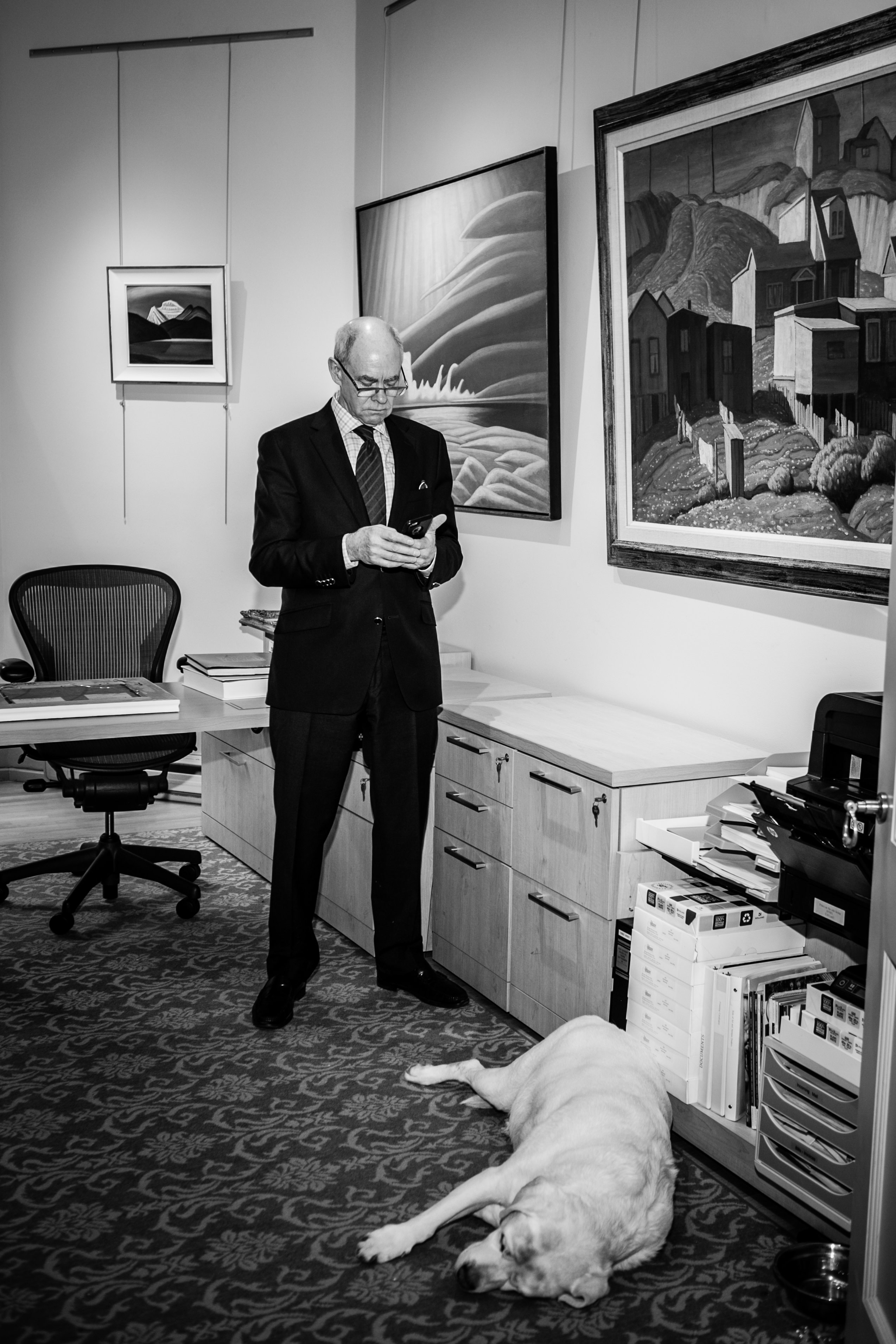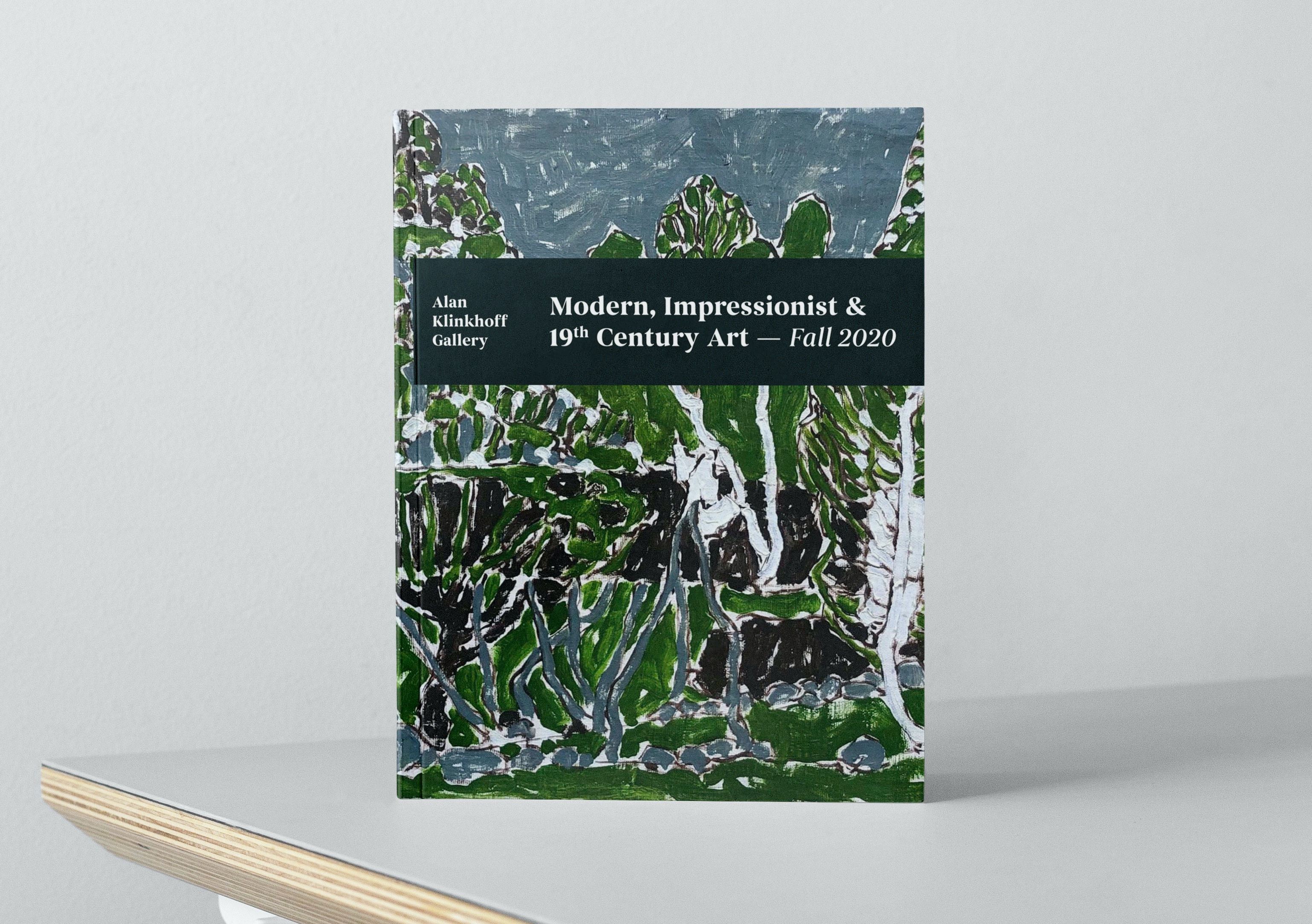Perspectives on the Art Market
The last seven months have introduced challenges, as well as opportunities, neither we nor others could have anticipated. For us, literally within days of our official launching of The Collection of Mitzi & Mel Dobrin, the most important single family collection of Canadian art ever offered for sale, we were obliged to close our doors at both our Montreal and Toronto locations. Klinkhoff.ca remained, however, open 24/7/365 throughout, where we even had a virtual tour available in 3D (if you have 3D goggles). The sale continues now, with the paintings available distributed between both galleries and consolidated in one space online at klinkhoff.ca. The majority of this genuinely outstanding collection is sold, with a number of extraordinary purchasing opportunities remaining, e.g. Tom Thomson’s Early Spring , Algonquin Park, Frank Johnston’s Tribute to Tom Thomson (circa 1923-1925), and the highly important A Y Jackson canvas, Early Spring, Quebec (1926).

A.Y. Jackson, Early Spring, Quebec, 1926. Oil on canvas, 24 x 32 in (61 x 81.3 cm). $550,000.
Credit is due to Craig and Jonathan for our ability to transition overnight to working almost seamlessly from our respective homes. This was invaluable for several weeks from mid-March on. With their leadership, Alan Klinkhoff Gallery continues to make an important commitment of financial and human resources to the development of our platform at Klinkhoff.ca. When the doors were shuttered, the entire inventory of our galleries’ walls was already hosted online, with the transparency of prices accompanying all works of art available, emails accessed from home, and telephone calls forwarded to cell phones.
With commercial transport curtailed or prioritised for emergency and medical supplies, one of our greatest obstacles, in candour, was actually delivering art work to clients. If you have ever heard me previously rant about the nightmare of obtaining federal export permits for artwork sent out of Canada, from mid-March and for a good 4 months thereafter, our experience with this bureaucratic nuisance was consistent with the worst of them. (Their expert examiners are prohibited from accessing these applications from home. Go figure!)
Of course, we’re back, with the doors open now for several months at both locations, and accessible, as always, 24/7/365 at Klinkhoff.ca. Business is certainly not “as usual”, however. Our challenge today is to offer to interested parties, wherever they may be, a visiting experience comparable to the one they would enjoy coming physically into the galleries and speaking to Jonathan, Craig or me. We encourage relationships with art collectors, and do our utmost to meet with clients and interested stakeholders in person, but alternatively to speak over the telephone, or FaceTime/Zoom if they wish, and failing that, via exchanges of emails. With Klinkhoff.ca and the transparency we offer, we strive to be lieutenants in building collections with collectors who do not have the opportunity to come by, chat, and see what lines our walls in Montreal and Toronto.
Admittedly, it doesn’t happen often these days, but a few weeks ago a gentleman, whom we had never previously met, walked into one of our galleries, looked around for quite some time, asked a number of very good questions about several fine pictures we were offering for sale, and then, focusing on one rather precious work in particular said , “May I buy this painting?” Our physical locations in Canada’s largest markets, therefore, continue to complement each other and Klinkhoff.ca, to the benefit of both sides of the buy/sell process. It remains a pleasure for Jonathan, Craig and me to respond to any and all questions about the fine art we offer.
Some of our colleagues, for reasons of their own, have spurned a development of their presence in cyberspace. Maybe some, until now anyway, were simply deniers or elected instead to rely on investments such as participation at art fairs for business development. They have been obliged to now look for internet-related marketing options. Some galleries found third-party platforms, where they could show and sell their artwork. There were also a few, a knowledgeable collector commented to me recently, who had essentially liquidated inventory through auction sites, perhaps out of necessity for cash flow purposes.
Throughout the spring and summer months, it has been private-treaty art galleries, offering contemporary art, which have unfortunately suffered the worst among our art dealing community. Even those who had developed a reasonable profile in cyberspace, simply by the nature of their supply now, and going forward in the short term, there is no shortage. Solo and group exhibitions have been cancelled or postponed. Artists have ongoing expenses. The only motivator for their buyer demographic is a discount in price. Some galleries in the contemporary market, sadly, will falter and leave many deserving artists without representation. One cannot imagine that, at least for the medium term, anyone would risk opening a new space in a mainstream location, accompanied by all the expenses and imponderable risks such a new venture would entail.
Our business is that of selling “classics”: works of fine art, of recognized and enduring value, that have been judged over a period of time to be of the highest quality and outstanding in their class. By definition, no such works are being painted today. Consequently, our supply is dictated by death, divorce, debt, downsizing and discretionary sales. The first 4 Ds continue to offer us a quantity of art work, of which perhaps only 20% is of sufficient quality to be pursued and brought to market.
After what has transpired in our market and in others of late, for those of us conducting private-treaty sales in galleries, the scarcity of supply in the marketplace of high quality fine art has confirmed price stability and purchase activity for genuinely important art: ones our friend, investment guru, Stephen Jarislowsky, refers to as “first quartile” pictures. We are presently entertaining discussions with a group of collectors, relatively new to our market, who, after looking around for a year or two, are giving serious consideration to purchasing a few of the “trophy” pictures our Dobrin sale has available. There is only the most remote possibility that one will be able to buy, in the foreseeable future finer works by Jackson, Johnston and Thomson than the ones we are offering. And if one has that opportunity, at what prices? Our experience throughout the summer months, with new acquisitions of high quality works, has been that there continue to be enthusiastic and receptive collectors to acquire them.
We constantly remind stakeholders that the selection of artwork we show is a “vetted” selection, each and every one a work we are proud to encourage clients to buy. Looking around at the evolution of the commerce of selling art, however, the costs of putting a load of pictures up for sale online are so low, and the profit margins so high, that there has been a proliferation of online auction sales where, let’s be honest, the “stuff” just isn’t any good. While the branding of these selling venues risks being downgraded with this eBay-style “quality” of supply, there is a generous financial reward to the shareholders. Inundated with offerings, it has become increasingly important for serious art buyers to limit their shopping to venues offering a professionally vetted selection and market-respected expert advice.

Alan Klinkhoff (left) with Winston in front of three paintings by Lawren S. Harris at Galerie Alan Klinkhoff, Montreal, in 2017
As we all acclimatize to the new normal, one which makes it difficult for interested buyers to visit the galleries in person, we sense that buyers are becoming increasingly comfortable making important purchase decisions based on the trust and confidence in our vetting process and the quality of images current technology permits us to send. Combined with the supporting dialogue Craig, Jonathan and I encourage, this facilitates purchase decisions despite the distance.
In complete transparency, we publish on our site our prices, which are “fair, fixed and firm”. In many businesses, the concept of doing so might not seem unusual. Alan Klinkhoff Gallery is a leader among the increasing number of galleries offering classic Canadian art in posting selling prices. (In order to guard confidentiality, for the benefit of the purchaser we do remove prices when works are sold.) With many galleries, “Price on request” continues to be the norm. The first and obvious question asked by any potential buyer of almost anything is “How much?” We ask ourselves why the price was ever a secret in the first place.
Mitigating risk, while achieving value, is the optimum objective of any seller of important fine art. Price protection and low aggregate commissions for the transaction at our fixed price, private-treaty platform enables sellers of high quality fine art to achieve these objectives. For buyers of such art, the availability of quality supply at competitive prices, offered with a financial efficiency that extends to no buyer’s premium, represents a purchasing opportunity. The advantage of price protection a private-treaty sale affords cannot be ignored, even by seasoned auction sellers and auction houses themselves. Our family has been in this business now for more than 70 years. In our experience there has never been a climate and market where there has been a greater risk in betting on the financial advantages of selling quality art under the gavel in a 3-minute period, on a designated day, 4 months forward. As we have experienced recently, anything can happen! Battling to plug the growing leak in their already less than 50% market share, perhaps in acknowledgement of the value of private-treaty sales, in which our family has specialized for seven decades, auctioneers are increasingly advertising that they conduct private treaty sales also, investing neither in additional and specialized veteran personnel with experience in private treaty salesmanship, nor in dedicated space.
Nationally and internationally, auction houses have taken the brunt of the suffering in the last 7 months. We have attended a good number of important auction sales in New York, London and Paris over our careers. The most successful sale is like a heavyweight boxing championship bout, where you have a referee (auctioneer), and two titans (wealthy bidders) battling it out (bidding ) to win the belt (the artwork). Today’s sales, with the visuals being the auctioneer, the artwork and a bunch of computer screens showing auction reps in various locations, just doesn’t replicate the electricity of a great auction. Without the crowd in the seats, the competition is simply not at the same level. (If you watched the Stanley Cup playoffs, you’ll know what I mean). Auctions need intense competition to be successful for sellers.
Come mid-winter, in our specialization of “classics” we anticipate that we may see additional discretionary supply come to market. With a resignation that the world will unlikely return to what it was 8 months ago for some time yet, if ever, some of those standing on the sidelines may come to the market. One should expect that those “trophy” works of art Mr. Jarislowsky refers to as “1st quartile pictures” will be offered and sold at strong values. For so-called “very good” pictures, however, values will probably remain as they are presently, a bit soft, excellent purchase opportunities for astute collectors . The rest, quite honestly, are not our market: we don’t recommend them and don’t pay much attention to their values.
In the meantime, we recently sold out a specialty collection of 16 paintings by the Charlevoix master artist, Claude Le Sauteur. You may be familiar with the legacy murals Le Sauteur spent the better part of two years painting for a cupola at Power Corporation’s Montreal offices. The collection we just sold includes 12 paintings of a series, The Universes of Laughter, and 4 additional paintings, featuring the iconic image of Victor, originally developed by Vittorio Fiorucci.
The combined Le Sauteur collection is illustrated in an important sales catalogue we are distributing later this month. Our Sale of Modern, Impressionist & 19th Century Art offers an excellent selection of high quality art for your purchase, which we anticipate will be well received by discerning art collectors. The list of artists includes especially fine works by Jean McEwen, Rita Letendre, Philip Surrey, David Milne, John Little, Rita Mount, James Lillie Graham, Robert Pilot, Maurice Cullen, J.E.H. MacDonald and other important names. The catalogue of the Mitzi and Mel Dobrin Collection, and our forthcoming presentation, are of a type we have featured with success previously. They demonstrate our interest and ability in hosting sales, not just of individual works of art, but entire collections. The quality of the presentation is attractive to individuals and families selling important fine art, where they can combine the most advantageous financial selling platform with a legacy publication, to be shared long in the future.

Our Modern, Impressionist & 19th Century Art Sale Catalogue is available for Pre-Order. The works are available for immediate purchase.
For any additional information about our sale of Modern, Impressionist & 19th Century Art , and how to participate as buyers now, or sellers through our next presentation, Craig, Jonathan and I invite your inquiries. Most importantly, we hope that you and yours are well and safe. If we can be of any assistance in any of your art-related interests, it would be our pleasure to hear from you.
Craig & Jonathan join me in sending our best wishes for your good health.
Comments
Hey, interesting and informative. Alan. Good to know that your firm has continued to be active in the art market. All the best.
As usual, so inspiring to read your blogs!!!



